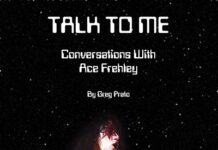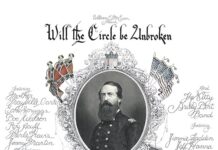Photo Courtesy of Stan Johnson
Before Amazon entered my life, I was forced to hunt for hard-to-come-by CDs the old-fashioned way — in America’s many, many Goodwill stores.
In one such store in Binghamton, New York, more than 10 years ago, I uncovered an important album in the collective discography of Yes frontman Jon Anderson — his 1988 solo album In The City Of Angels.
Like its title implies, Anderson’s fifth solo album is riddled with spiritual connotations, sunshine, gloss and trends of the era. In other words, it’s vastly different from say, Close To The Edge and Tales From Topographic Oceans. Yet it arrives during an important period in Anderson’s own life. Prior to its release, Anderson tasted rock superstardom with Yes’ first Number One U.S. hit “Owner Of A Lonely Heart” and the accompanying triple platinum-selling album 90125 (albeit without Yes stalwarts Steve Howe and Rick Wakeman in the lineup). He also endured a troublemaking follow-up with his Yes-mates, 1987’s Big Generator.
While the now 30-year-old In The City Of Angels is easily Anderson’s most poppy and danceable effort to date (just look at the made-for-MTV music video for “Hold On To Love” or take one listen to “Betcha”), don’t let its commercial undertones detract from its strengths — particularly Anderson’s jubilant vocals. As for Anderson, he readily heaps praise on it three decades later, despite its lackluster sales stateside.
“I thought this was going to be a big, big album for me as a solo artist. I never thought of myself as a solo artist but I thought, ‘This is going to be great,’” Anderson recently told me during a phone interview from his central California cottage/studio. “I was truly very excited, and it shows how wrong you can be because the album really didn’t do too well.”
Anderson, currently at work on his memoirs, adds: “Of course, I always felt I was too old to be a pop star but in the 80s after 90125 I thought, ‘Anything is possible!’”
Hunkering down in L.A. with both the multi-talented members of Toto, and lyrical genius Lamont Dozier of Holland-Dozier-Holland/Motown fame, Anderson set about writing new material, free from the constraints of being in a different kind of big band — arguably the greatest one prog rock ever produced.
“Basically, going on tour with 90125, it was very big and very brash …It wasn’t that friendly to me. I was up there singing and everybody was doing their thing, but I didn’t feel part of the team. I was part of the big experience,” Anderson told me. “Working with Toto was like being in a team again. I could talk to them, come up with ideas. They were very open and the creative process was great. Everybody seemed to be in top-form musically and the production was great.”
Anderson feels similarly about his recording experiences with Vangelis, the Greek instrumental powerhouse best known for his Academy Award-winning soundtrack to Chariots Of Fire. The duo would release four albums within a dozen-year span. Their first collaboration came in 1975 with Anderson contributing vocals to “So Long Ago, So Clear” for Vangelis’ seminal Heaven And Hell album (a must for synth fans!). For die-hard Yes aficionados, you may remember Vangelis was Anderson’s suggested replacement upon Rick Wakeman’s first departure from the group. The job ultimately went to Patrick Moraz.
“(Vangelis) was the first multi-keyboard player I had heard sustaining a composition totally by himself. Up until then I’d worked with Rick Wakeman who could play all the keyboards but not in a simultaneous way,” Anderson said. “Vangelis was this phenomenon musically speaking. Everything was chance music — you didn’t sit down and start writing chords and play them. You just played.
“It was totally the opposite to Yes,” he adds. “Yes was structure, defined, organized …You work with four people and it’s a constant organization of music. With me and Vangelis, it was actually the opposite; it was this spontaneous event. Maybe we did five songs a day for a week and maybe two of them each day worked. By the time we had the first album [1980’s Short Stories], we were mesmerized by the way we could create. It was kind of amazing.”
But if you ask Anderson to compare his In The City Of Angels recording experience with that of the platinum-selling Big Generator, it’s night and day. Along with Anderson being asked to contribute his vocals well into the recording, as opposed to right at the beginning, the album would also take more than two years to complete across different global locations, prompting group tensions to arise.

“There was something about them not wanting me around because I could be like a Svengali at times — like, ‘I want to try this out,’ ‘Let’s be adventurous.’ In the 70s, everybody just accepted that’s how I was. But in the 80s, I think they were like, ‘Jon, you don’t know anything about making a hit record so come back when we finish the album,” Anderson told me. “It never really got made, that album. We just sort of stumbled along for nearly two years. Meanwhile, I carried on creating new music at the time.”
In The City Of Angels is the culmination of several influences — Anderson immersing himself in Hopi Indian culture and perseverance (“Sundancing (For the Hopi/Navajo Energy), “New Civilization”); indigenous cultures; even Hermann Hesse’s forward-thinking work The Glass Bead Game. Retitled as “Top Of The World (The Glass Bead Game),” this track contains one of Anderson’s most prophetic lyrics, “I’m a river, I love you.” To this day, I don’t know why it impacts me so, but it’s held great meaning in my life, especially after ascending to and descending from the ancient Masada in Israel around the time I purchased the album.
Like Tales From Topographic Oceans, which was indirectly inspired by Paramahansa Yogananda’s Autobiography Of A Yogi, I plan to buy Hesse’s book and try to glean greater wisdom from it.
Yet for a positive album that boasts abundant references to love, success wasn’t forthcoming. Anderson himself would not tour in support of it given public response.
“Of course, after the album didn’t do so well, I just thought, ‘Maybe it’s my fault,’ I don’t know. I thought the songs were great, but what could you do,” he said, adding, “And the record company maybe thought, ‘Eh Jon Anderson, he’s OK with Yes but by himself…’ blah blah blah.”
Fortunately, apart from my being a fan of this underrated work, the entire province of Quebec apparently loves it, according to Anderson. He uncovered this fact a decade earlier while doing solo performances there. Even Anderson’s concert promoter had the album on at full blast in his office.
“I went into the office and said, ‘OK guys, you don’t need to play this album. Why are you doing that?’ And he said, ‘What do you mean? It’s a big record here in Quebec province. This was a Top 10.’ And I said, ‘Wait a minute, can you say that again?’,” Anderson recalled. “That kind of freaked me out because it was like nearly 20 years later and there it was. It was a hit record. I always thought it was.
“I love the album and I loved everything about it,” he adds. “The joy of being in Quebec province and finding out the album was a hit there made it all worthwhile 20 years later.”
***
Share your feedback and suggestions for future columns with Ira at vinylconfessions84@gmail.com.




















